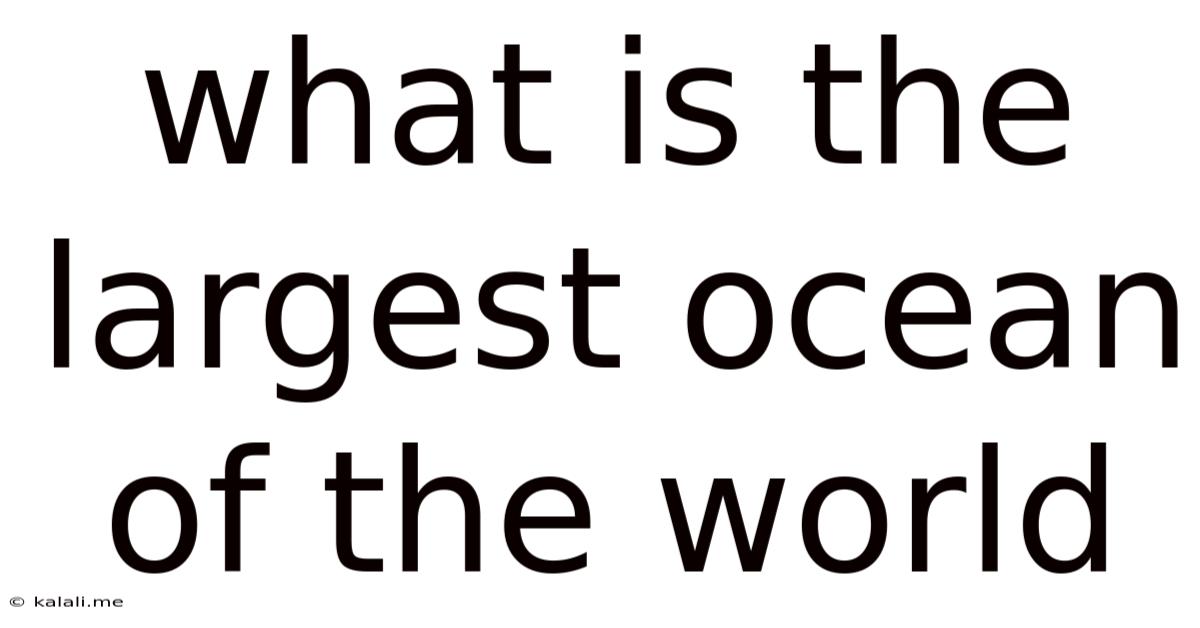What Is The Largest Ocean Of The World
Kalali
Jun 11, 2025 · 2 min read

Table of Contents
What is the Largest Ocean in the World?
The Pacific Ocean holds the title of the world's largest ocean, covering more than 63 million square miles (165.25 million square kilometers). This vast expanse of water dwarfs all other oceans in size and depth, boasting incredible biodiversity and a history stretching back millions of years. Let's delve deeper into the Pacific's dominance and explore some of its fascinating features.
The Pacific's Immense Size: A Global Giant
The sheer scale of the Pacific Ocean is almost incomprehensible. It covers roughly one-third of the Earth's surface, exceeding the total land area of all the continents combined. To put it in perspective, all of the world's other oceans – the Atlantic, Indian, Arctic, and Southern – could fit within the Pacific's boundaries with room to spare. This immense size directly impacts global weather patterns, marine ecosystems, and even geological activity.
Exploring the Pacific's Depths: Trenches and Underwater Mountains
The Pacific Ocean is not only vast in surface area but also incredibly deep. It contains the deepest known point on Earth, the Mariana Trench, plunging to a staggering depth of nearly 7 miles (11 kilometers). These extreme depths host unique ecosystems adapted to crushing pressure and perpetual darkness. Beyond the trenches, the Pacific floor is a complex landscape of underwater mountains, volcanic ridges, and vast plains. These features are constantly being shaped by tectonic plate movement, making the Pacific a dynamic and ever-changing environment.
A Biodiversity Hotspot: Marine Life of the Pacific
The Pacific's enormous size and diverse habitats support a staggering array of marine life. From the vibrant coral reefs of the tropics to the frigid waters of the polar regions, the ocean teems with countless species of fish, mammals, invertebrates, and plants. Iconic creatures like the blue whale, giant squid, and various species of sharks call the Pacific home. This incredible biodiversity is, however, facing increasing threats from human activities, highlighting the importance of conservation efforts.
Geographic Significance and Human Impact
The Pacific Ocean's location plays a crucial role in global trade and transportation. Major shipping lanes crisscross its waters, connecting continents and economies. However, this heavy maritime traffic, along with pollution and overfishing, poses serious challenges to the ocean's delicate ecosystem. Climate change, manifesting as rising sea levels and ocean acidification, presents further threats to the Pacific's health and its incredible marine life.
Conclusion: Protecting Our Largest Ocean
The Pacific Ocean, the world's largest and deepest ocean, is a treasure trove of biodiversity and a vital part of the Earth's system. Understanding its immensity, its geological features, and the interconnectedness of its ecosystems is crucial for developing effective strategies to protect this invaluable resource for future generations. The continued health of the Pacific Ocean is essential not only for marine life but for the well-being of the entire planet.
Latest Posts
Latest Posts
-
How Many Tbsp In A Dry Ounce
Jul 02, 2025
-
How Do You Say Grandparents In Spanish
Jul 02, 2025
-
How Many Numbers Are Between 48 To 24
Jul 02, 2025
-
How Many Positions Are There In Sex
Jul 02, 2025
-
How Many Minutes Are In 10 Miles
Jul 02, 2025
Related Post
Thank you for visiting our website which covers about What Is The Largest Ocean Of The World . We hope the information provided has been useful to you. Feel free to contact us if you have any questions or need further assistance. See you next time and don't miss to bookmark.